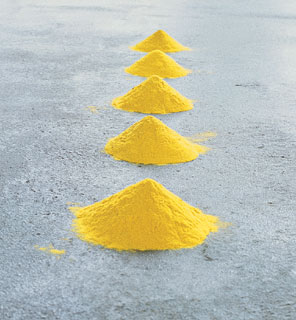|
| |
 |
|

|

The Five Mountains Not to Climb On (Die fünf unbesteigbaren Berge), 1984. Hazelnut pollen, height: approximately 2 3/4 inches. Collection of the artist.
|

Wolfgang Laib finds spirituality in the simplicity of everyday, organic substances—milk, pollen, beeswax, rice—that provide sustenance or engender life. In 1975 he created his first Milkstone in what has become an ongoing series of elemental sculptures. A rectangular block of polished white marble containing a slight depression on its upper surface, the piece is filled with a thin layer of milk to foster the illusion of a solid form. Though an inert object, this sculpture requires ritualistic participation. Laib performs the first act of pouring the milk when the piece is displayed, but after this initial gesture, the collector or museum staff must clean and refill the stone each day it is on view.
Ritual plays a central role in all of Laib's highly reductive art. He lives in a remote region of Germany's Black Forest, communing with the natural world outside his house as a painter would work in his or her studio. During the spring and summer months he collects pollen, including dandelion, hazelnut, pine, buttercup, and moss varieties, from the fields surrounding his home. He displays this laboriously gathered material in simple glass jars or sifts it through sheets of muslin directly onto the floor to create large, square fields of spectacular color. He also molds the brilliantly pigmented dust into cones, as in The Five Mountains Not to Climb On. Though intimate in scale and intensely fragile, this hazelnut pollen sculpture alludes to the monumentality suggested by its title. The notion that there is infinitude in the infinitesimal is beautifully manifest in Laib's spare but highly aesthetic practice.
|
|